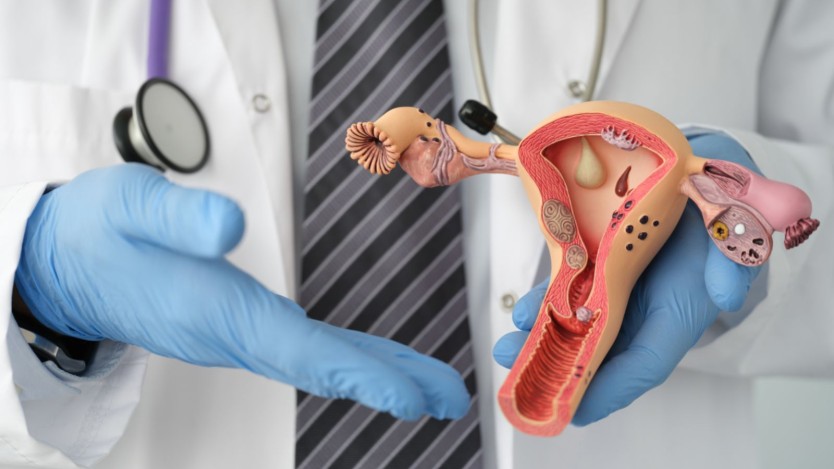Ureteroscopy: what it is, what it is used for, advantages and risks

- What is an ureteroscopy?
- When is ureteroscopy recommended for urinary stones?
- Types of ureteroscopy
- Pre-operative and pre-operative advice for ureteroscopy
- Ureteroscopy: step by step
- Indications to be considered after discharge
- Advantages of performing ureteroscopy
- Are there any risks involved in ureteroscopy?
- Request for consultation for holmium laser lithotripsy via ureteroscopy
- Ureteroscopy is an operation to examine the inside of the kidney and ureter using a ureteroscope. It allows 90-95% of stones to be destroyed and requires general anaesthesia.
- Ureteroscopy consists of introducing an endoscope with a laser through the urethra, bladder and ureter to destroy the stones by fragmenting them.
- It is important to hydrate well in order to reduce the intensity of symptoms such as the appearance of small fragments in the urine or pain in the days following the operation.
What is an ureteroscopy?
Ureteroscopy is a urinary stone removal technique, which involves inserting a ureteroscope through the urethra to explore the ureter from the bladder to the kidney. This procedure can help diagnose and treat problems in the urinary tract, the most common cases being kidney stones.

Do you need ureteroscopy surgery?
Request a free and immediate appointment with our specialists in Urology
To perform this procedure, a ureteroscope is used, which is a thin, tube-shaped instrument with a light and a lens for observation. It may also have an additional tool to extract tissue for later analysis to detect signs of disease.
The instrument is also used to introduce a holmium laser fibre to fragment stones or remove a tumour.

There are two types of instruments used for this treatment:
- Rigid ureteroscope, used for procedures that involve reaching the lower ureter, particularly below the iliac vessels, closer to the bladder; they are preferred by specialists for their easy insertion, direct vision, excellent image transmission and control of the working instrument and its accessories.
- Flexible ureteroscopes are used for procedures that involve reaching the upper ureter and the intrarenal collecting system, which is closer to the kidney, as they allow better passage through the ureteral angles, and allow access to the entire collecting system in 90% of patients.
Although it is not a very invasive treatment, specialists describe it as a more invasive procedure compared to others, such as extracorporeal lithotripsy, but it achieves almost complete removal of the stones present in the kidney.
When is ureteroscopy recommended for urinary stones?
Urological specialists recommend ureteroscopy in the following cases:
- If the patient has stones in the ureter, which cannot be expelled naturally or are causing great discomfort.
- If the affected person has kidney stones that cannot be treated with shock waves.
- Also in some cases, in order to detect the problem in patients whose symptoms include the appearance of blood in the urine, it is called diagnostic ureteroscopy.
- For the removal of urinary tract tumours, when it is superficial and not very extensive.
- Stenosis (narrowing) of the ureter is also treated with this technique.
Depending on the problems of each case, different types of ureteroscopies are performed, and the following is a breakdown of the different procedures.
Types of ureteroscopy
This technique has different modalities or types, among which we highlight the following:
Ureteroscopy for stent catheter placement.
This is a procedure in which a ureteral catheter is placed to relieve any obstruction of the ureter, i.e. the pathway blocked by a stone, internal tumours or external material produced by a disease is opened.
These catheters that are placed serve several purposes. If it is a kidney stone that is broken up by the laser, the stent catheter provides a layer of protection for larger stone fragments to pass through without damaging the ureter.
The stents maintain the dilatation of the urethra for better handling of the instruments during the procedure allowing urine to pass without blockage, thus relieving discomfort. In addition, the stents provide support during the healing process.
Ureteroscopy for stone extraction
During this procedure, ureteroscopy is used to remove stones from the ureter by manipulating their position with forceps ending in a basket and the rest of the instruments. The surgeon inserts the small basket through the ureteroscope and collects the stone, removing it from the body.
Ureteroscopy with holmium laser lithotripsy
This is the most commonly used and is mainly used in cases where the stone is too large. In order to extract it with the basket forceps and remove the stone, the laser is used to break the stone into smaller pieces, thus facilitating its elimination.
The stone fragments can then be removed with the basket or passed naturally in the urine. You can read more about holmium laser lithotripsy by ureteroscopy by clicking here.

Ureteroscopy for tumour removal or biopsy
In addition to the use of ureteroscopy for tumours, it is rare but the ureteroscope can be used as a conduit to access the affected area with laser forceps and perform a biopsy to check whether the tumour is malignant or benign.
The tool required is mainly a brush, which is used for the collection of internal tissue from the affected area, usually the ureter, and its removal for further microscopic evaluation.
Before any type of ureteroscopy is performed, it is advisable to take into account the following indications. All of them are important for the patient to be properly prepared for the operation and to have a better recovery afterwards.
Pre-operative and pre-operative advice for ureteroscopy
First of all, it is necessary to take care of the most everyday aspects, such as diet and the consumption of medicines, the latter having to be reviewed and regulated by the medical team that will carry out the procedure. Other recommendations are as follows:
- Refrain from eating or drinking at least 8 hours before surgery.
- Inform the surgery planning staff if you are taking anticoagulant medication. This is very IMPORTANT.
- Stop taking medications such as aspirin or related blood thinning medications at least 7 to 10 days prior to surgery.
- In case of having to take any medication prescribed by specialists on the day of surgery, the patient should take it with just a sip of water.
Beyond the advice directly related to the medical aspect of the process, there are other types of advice to be taken into account:
- Wear loose-fitting, comfortable clothing. To avoid overexertion when changing.
- Do not forget to leave personal valuables such as jewellery, watches or money at home.
- Bring a relative or person you trust to accompany you from home to the hospital and from the hospital to home. In the event that the patient is operated on by Operarme, the company provides a transfer service to take the patient from home to the hospital and from the hospital to home on the day of admission and discharge.
Ureteroscopy: step by step
Firstly, after the patient attends a surgical assessment consultation with a Urology Specialist and decides to carry out the ureteroscopy intervention to remove the stones in the kidney or ureter, it is necessary to carry out a complete preoperative examination to determine the patient's health.

Do you need ureteroscopy surgery?
Request a free and immediate appointment with our specialists in Urology
On the day of admission, the patient is provided with clothes in the pre-surgical room and, once in the operating theatre, the urologist will show the patient how to get dressed and the operation will begin.
The anaesthesiologist, the surgeon and a member of the medical team will be present during your stay in the operating theatre.
After that, the holmium laser lithotripsy surgery begins:
- The urologist, after having anaesthetised the patient, will proceed to dilate the urethra to allow access to the ureteroscope, a small tube with a camera and a light at the end that allows the surgeon to see the inside of the urinary tract through a monitor.
- The ureteroscope also allows the holmium laser fibre to be passed through the urethra to the kidney stone site so that it can destroy the stone. This is made possible by the flexibility of the ureteroscope.
- The ureteroscope is inserted into the urethra and bladder until it is inserted into the ureter (a small tube that carries urine from the kidneys to the bladder) or kidney. Contrast x-rays may also be taken of the ureters so that the urologist can see where the stone is and if there are any other abnormalities. Once in the bladder, the surgeon fills the bladder with a saline solution that improves its visibility and allows easier access to the ureter.
- When the surgeon gains access to the kidney, or the area where the stone is located, it will be destroyed using any of the three common techniques, which are direct fragmentation, the most commonly used for small stones in complex areas, multiple drilling, which consists of drilling a large number of holes in the stone to facilitate fragmentation and extraction, and ablation of a superficial cavity, which consists of drilling a large hole in the stone to fragment it into a few pieces.
- In some cases a stent catheter is temporarily placed in the ureter, a small tube that facilitates the flow of urine into the bladder, so that the ureter can remain inside after the operation. There is also the option of a urinary catheter, which is placed from the urethra into the bladder, allowing urine to flow out of the bladder. In addition to administering fluids to the patient to properly hydrate them.
- After its removal, the surgeon will observe that everything has been done correctly and will place a probe to facilitate the removal of the remaining residues.
- Next, all the material is removed and the patient is woken up and taken to the recovery room where he or she will finish recovering from the anaesthesia.
- Finally, the catheter or stent is removed shortly after surgery and the patient's condition is assessed for discharge, as long as the patient does not have fever, severe pain and has sufficiently emptied the bladder.
This procedure usually lasts 1 hour.
The patient may experience mild to moderate pain in the lower abdomen and the need to urinate more frequently. These symptoms are due to the presence of the catheter or stent, but to alleviate them, the patient should consult with the specialist about the analgesic medication that can be taken.
Indications to be considered after discharge
Before the patient is discharged, the specialist will give instructions on rest, precautions and physical activities that can be carried out on returning home.
The aim is to speed up the recovery process and ensure that the condition has been successfully resolved.
In cases where the patient has had a double J stent inserted during the procedure and it has not been removed before discharge, the specialist will indicate when it will be removed, usually after several days.
As this is an operation involving the insertion of instruments into the urinary tract, the patient may experience symptoms of discomfort when urinating for some time, mainly related to the inflammation of the area after the ureteroscope has been inserted, but these will gradually disappear completely.
Some of the most common symptoms you may experience are:
- Mild stinging sensation when urinating
- Appearance of blood in the urine
- Mild discomfort in the bladder or kidney area when urinating
- An increased need to urinate more frequently

During the first few weeks, the patient should take the following precautions into account:
- It is recommended to drink water frequently, in small quantities, thus helping to go to the bathroom more frequently and eliminate any remaining matter.
- Avoid sexual relations, especially during the first week after surgery, in order to avoid possible urinary tract infections.
- Eat more greens and vegetables and less meat, so that the stools are softer and the straining during defecation does not damage the healing process.
- Keep the body rested during the first week after the operation. It is recommended not to lift more than 5 kg and to go out for short walks. After the first week, exercise can be resumed.
Advantages of performing ureteroscopy
Compared to other interventions, ureteroscopy allows in most cases to visualise the stone directly and therefore to introduce special instruments such as the holmium laser to break it.
Another advantage of this procedure is that the ureteroscope passes through the body's natural channels and therefore no skin incisions are required. In cases where the stone can be seen, it is easier to remove the stone(s) in a single session.
The flexible ureteroscope facilitates access to any area of the kidney, making it possible to fragment and remove stones of significant size.

Do you need ureteroscopy surgery?
Request a free and immediate appointment with our specialists in Urology
Are there any risks involved in ureteroscopy?
Ureteroscopy is a minimally invasive procedure and rarely presents complications. However, the potential risks and complications with this surgery are:
- Residual stones within the kidney or ureter: these may be present for some time after ureteroscopy, depending on the original size of the stone and the location within the urinary tract. This problem usually resolves over time with the consumption of water and is then released by urination.
- Ureteral injury: This is an injury to the ureter resulting from a complication during the operation. The risk of perforation varies greatly, depending on the severity of the perforation. This type of complication is usually resolved with the help of a stent that is left in place for a longer period of time, lasting 2 to 4 weeks.
- Ureteral stricture and avulsion: Ureteral stricture is scar tissue inside the ureter and ureteral avulsion is the complete separation of the ureter from the kidney. These types of injuries are the most complicated and less common thanks to the technical capabilities of the new surgical instruments.
- Hermaturia and infection: The probability of suffering this type of problems after ureteroscopy is very low, but most of these are very limited and are resolved with hydration and the prescription of antibiotics.
Request for consultation for holmium laser lithotripsy via ureteroscopy
If you are considering surgery, you can request a surgical assessment consultation with one of our Urology specialists by clicking below:

Do you need ureteroscopy surgery?
Request a free and immediate appointment with our specialists in Urology
Medical disclaimer: All the published content in Operarme is intended to disseminate reliable medical information to the general public, and is reviewed by healthcare professionals. In any case should this information be used to perform a diagnosis, indicate a treatment, or replace the medical assessment of a professional in a face to face consultation. Find more information in the links below:



